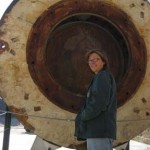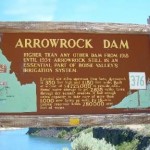On late Friday afternoon I went to hear two speakers brought in by the Boise State Group for Early Modern Studies. Both speakers had wonderful presentations about how knowledge was made public in the 17thcentury. They both had really great images on Power Point to go with their talks. I found myself smiling and thinking how much their presentations would be enhanced if the images were 3D or more interactive.
Author: Ellen
National Park Service Historian
National Parks were places my family visited on driving vacations. As a very young child I was happy to note that these parks were run by people dressed appropriately like Ranger Smith in the Yogi Bear cartoons. These rangers worked outdoors and told us about animals and plants and camping. What puzzled me was when we would take guests from our suburban New Jersey home into New York City to Theodore Roosevelt’s Birthplace and people in ranger uniforms would lead the tours. Eventually I figured out that the National Park Service was not all about “parks”, but also about historic sites.
By chance this past January a cousin of mine was telling me about one of his in-laws who has worked for the National Park Service for years. Through my family connections I decided to inquire if anyone knew a NPS Historian I could interview for this assignment. I received an e-mail informing me I had “hit the jackpot” and was given contact information for “my dear, long-time friend Dwight Pitcaithley” who served for a decade (1995-2005) as the Chief Historian of the National Park Service.
Before I tell his story I want to jump ahead to Dwight’s advice to people thinking about a career in Public History. “Be open!” I suspect that that is more an attitude toward life he embraces and is what led Dwight down some roads and paths he never expected to follow as a young man.
Dwight grew up in Carlsbad, New Mexico in the 1940s and 50s. He’s gone full-circle and returned to that part of the country in the semi-retirement phase of his life. He currently is a history professor at New Mexico State University in Las Cruces. In the early 1960s he was a talented enough drummer/percussionist that when he headed off to college ( the name of which he didn’t divulge) he had every intention of earning a degree in music. After 2 frustrating years he and his music department agreed he was failing miserably. He could read and play rhythms, but that did not compensate for his inability to read music. He didn’t have an educational backup plan and though it was a risky choice at that period in time, he signed up for 3 years in the Marine Corps.
He did return to civilian life and he did re-enroll in college, just at a different institution, Eastern New Mexico University. He took a required History class, it captured his interest and he never looked back. By 1976 he had worked straight through his B.A., M.A., and PhD, all in History. While in his PhD program at Texas Tech University in Lubbock the National Park Service came looking for a graduate student who would be willing to spend a summer in Arkansas. The NPS was compiling a history report on the Buffalo National River and needed a researcher. That project started his extensive life-long writing side work. (I counted over 30 publications listed on his Curriculum Vita..) His work also caught the attention of the NPS to the extent that as he finished his PhD they offered him a job with their Southwest Region based in Santa Fe. His work in that office as a NPS Historian focused on the Third Fort Union.
In 1979 he was promoted and moved with his family to the Boston area where he was a Regional Historian for 10 years. In that position he considered himself a coordinator. He was a cultural resource manager. He dealt with historic properties and made sure everything was in line with the National Register and the National Preservation Act. In 1989 he went to Washington, D.C. to become the Chief of the Division of Cultural Resources, another administrative coordinator position covering the National Capitol Region. When the Chief Historian for the National Park Service retired in 1995 Dwight took over what he calls “the best job in Federal government”.
He saw a need for National Park Service historians and interpreters to receive more and different training. They all had been given plenty of help with how to give a presentation, but not so much concerning what information was being presented. He had some heated years with Park Superintendents because he wanted to incorporate new scholarship into park programs. For example, not everyone liked the idea of having to talk about the causes of the Civil War ( that slavery issue) rather than just the movements of the battles. It was essentially a change in a policy that had been around since 1933. He encouraged more reading, more course work, more workshops and increased understanding of history.
Dwight’s professional experience goes way outside the bounds of the National Park Service. He has been heavily involved with the National Council on Public History. He served on their Board of Directors, was the President of that organization, writes for their journal The Public Historian, and is on that editorial board. He was an adjunct professor at George Mason University. He also was on the Board of Directors and was President of the George Wright Society for protected area professionals dedicated to preservation of cultural and national parks and reserves.
Dwight’s current classes at NMSU include one on Civil War politics and one called Interpreting Historical Places. He uses computers and recognizes that mobile and digital devices are the way of the future. He thinks he’ll leave that technology to up and coming historians. Going back to his advice…”Be Open!” to opportunities to do something extra: learn new technology skills, photography, inventorying, volunteer, build your resume, join the National Council on Public History (they have student memberships), read voraciously, travel…
Whole New World
One of the reasons I wanted to take this class is because I am someone who has not entered the 21st Century enthusiastically about technology. I do have a computer but only since last summer high speed internet. I do have a digital camera but I often forget to bring it with me. I don’t have a cellphone. I certainly understand the appeal of gadgets but for me to spend my money and time with them I like to see a purpose. This week’s readings were a helpful introduction for me to see the wide variety of ways people share information. I enjoyed spending time looking at some of the historical walking tours and what people wrote in Were You There?. I have to admit to thinking, “Really?!?” at the Whole Foods “trip” button on Gowalla.
Ensign Valve
That seemed a likely place to put the valve, but that’s not where the valve is displayed. For people who just make the trip that far and don’t want to travel past the pavement, they will never know about or see see the valve display.
- It takes up space in the turnout that vehicles use and need for safety.
- It’s a distraction from driving on a section of road that requires attention.
- Anything interesting and not in full sight placed along that road is subject to graffiti and is likely to become a target for gun shot. (The sign already has spray paint on it.)
- The wire rope surrounding the valve does not discourage or prevent people from climbing all over it.
- If a better idea for preserving it ever came about, its size, weight, and present mounting might be prohibitive in moving it elsewhere.
How the Boise River water flow is regulated and how our fantastic irrigation system was developed and continues to be maintained have helped Boise to exist and grow. Remembering and preserving a piece of the technology that helped that system for almost 100 years seems important. The choices made for the ensign valve display seem thoughtless.
Racial Landscapes
While reading Chapter 12 in Everyday America about the racial landscapes I gave some thought to the few ethnic neighborhoods in Boise’s past and those that may be developing as refugees are placed in certain Boise neighborhoods. This explanation of racialized landscapes from page 203 brought to mind another Idaho connection: “American cultural landscapes that are particularly implicated in racist practice and the perpetuation of (or challenge to) racist social relations.” After the Japanese attacked Pearl Harbor and we entered World War II, Idaho became home to the Minidoka War Relocation Center, a.k.a. an internment camp complete with barbed wire fences and watch towers.
If anyone is planning a trip to Burley to see the wagon ruts swing off the highway east of Jerome and Twin Falls to a little place called Eden. On some maps the site of the camp is referred to as Hunt Station. I’ve heard a few stories on Boise State Public Radio in the last several years about the camp site. It made the news partly because it was made a National Historic site which is overseen by the National Park Service. More recently there has been some controversy because a cattle feeding operation wants to build a facility about 1 ½ miles from the site. Ironically, the camp held about 13,000 internees and the feed lot is proposed to handle about 13,000 head of cattle. Those opposing the permit feel that smell and noise would greatly effect the experience of visitors to the camp. Last fall I heard that the decision to grant the permit was upheld in court.
Coincidentally, last fall I picked up a novel called Hotel on the Corner of Bitter and Sweet by Jamie Ford. The main characters in the book lived in the already segregated Chinese and Japanese sections
of Seattle, Washington at the start of WWII. Part of the story centers on the relocation of the residents of the Japanese section to camps, many specifically to Minidoka. If I remember correctly 2/3 of those interned were American citizens by birth. What was barren, southern Idaho desert landscape…very cold in winter and very hot in summer became for the years 1942 to 1945 a racial project. Now it is an area about which decisions have to be made as to what is valuable to preserve.
Thoughts after reading Grady Clay’s essay on cross sections…
My family took the jingle “See the USA in your Chevrolet” to heart in in the 1960s and 70s. We logged thousands of miles in our Chevy Nova station wagon. By the time I graduated from High School I had driven through 41 states. Grady Clay’s description of his cross section method brought back lots of memories of our travels off of interstate highways. We were on the road to meet people and to see and learn about different places.
I like J.B. Jackson’s name the “Stranger’s Path” as a way to learn about an unfamiliar place. The “Stranger’s Path” could also be the “Insider’s Path” for those who live in a particular city. My family moved to Boise in 1973. I learned to drive here long before the construction of the roadway we call the Connector and I was a teenaged shopper here pre-Boise Towne Square Mall. I lived away from Boise for several years in the 1980s and when I moved back to Boise in the 1991 I had to decide how to deal with the change in traffic patterns and the emptiness of Boise’s downtown. I didn’t use the Connector because I still knew perfectly good ways to get places and driving so far out to the mall seemed inconvenient. Now I’m just stubborn. Friends who’ve never known Boise without the Connector or the Mall are always interested to ride with me and see which route I’ll take. I’m always surprised by their comments about how they’ve never seen certain parts of Boise.
I love reading travel books that include lots of history and human interest stories. Here are some of my favorite book titles about “roadtrips” in the U.S.:
Harry Truman’s Excellent Adventure by Matthew Algeo. The author revisits a “roadtrip” taken by Harry and Bess Truman after they left the White House. Harry Truman was the last President able to travel with freedom as a private citizen.
States of Mind : A Search for Faith, Hope, Inspiration, Harmony, Unity, Friendship, Love, Pride, Wisdom, Honor, Comfort, Joy, Bliss, Freedom, Justice, Glory, Triumph, and Truth or Consequences in America by Brad Herzog. The author and his wife traveled the United States visiting towns with these names.
On the Road by Charles Kuralt
Travels with Charley by John Steinbeck
A book on my “to read“ list:
The Magic Bus: An American Odyssey by Douglas Brinkley. The author is a college professor and historian I heard speak at the Idaho Humanities Council dinner last fall. He takes students for on-the-road class experiences to historical sites and to meet people involved in politics and literature.


